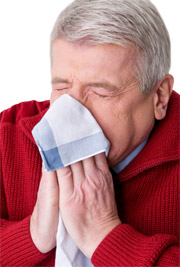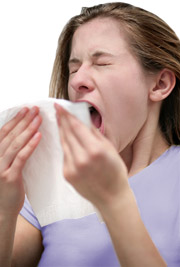- What is hayfever or seasonal rhinitis?
- Statistics on hayfever
- Risk factors for hayfever
- Progression of hayfever
- Symptoms of hayfever
- Clinical examination of hayfever
- How is hayfever diagnosed?
- Prognosis of hayfever
- Treatment of hayfever
- References
What is hayfever or seasonal rhinitis?
Allergic rhinitis is an allergic disease which affects many people worldwide. Rhinitis means ‘inflammation of the nose’, whilst the term allergic describes ‘a normal but exaggerated response to a substance’. It may be perennial, which means symptoms are present throughout the year, or seasonal, with symptoms peaking during the months of spring and summer when pollen levels are at their highest.
Seasonal rhinitis, also known as hayfever, is characterised by irritation and congestion or watering of the nose, itchy eyes, ears and throat, and sneezing. It occurs due to an exaggerated response to an environmental trigger which results in inflammation of the lining of the nose (see picture below).In the case of seasonal rhinitis, pollen is the most common trigger, hence symptoms are usually experienced during the spring and summer months when the pollen season is at its peak.

Statistics of hayfever
The prevalence of seasonal rhinitis varies worldwide. Many people do not seek treatment hence the exact figures for allergic rhinitis are often under-reported, however it is universally acknowledged that it is an extremely common condition. The 2004-05 National Health Survey stated that 3.2 million Australians (approximately 16.1% of the population) self-reported experiencing symptoms of hay-fever and allergic rhinitis. The prevalence was found to be highest amongst those aged 25-34 and was slightly higher among females (1.7 million) than males (1.5 million).
Number of people with allergic rhinitis (by age)
| Age | 0-14 | 15-24 | 25-34 | 35-44 | 45-54 | 55-64 | 65-74 | >74 | Male | Female | Total |
|---|---|---|---|---|---|---|---|---|---|---|---|
| Prevalence (thousands) |
303.4 | 521.8 | 618.6 | 601.7 | 528.6 | 315.1 | 158.2 | 118.3 | 1463.5 | 1702.2 | 3165.7 |
Percentage of the population with allergic rhinitis (by state)
| State | NSW | Vic | Qld | SA | WA | Tas | ACT | Aust |
|---|---|---|---|---|---|---|---|---|
| % Population | 13.8 | 18.2 | 14.1 | 20.9 | 18.8 | 14.7 | 21.6 | 16.1 |
Risk factors for hayfever

- Genetics: Atopy is inherited as an autosomal dominant condition.
- Maternal and neonatal factors: Such as smoking in pregnancy and early childhood, low birth weight, birth during the pollen season (though this is still being debated), early introduction of formula and food.
There is much research underway into other factors which may predispose to atopy in childhood, including early exposure to allergens in the environment, and maternal and early childhood diet. Exposure to allergens is the second component of allergic rhinitis. Seasonal rhinitis (hay fever) is caused by grass pollens, tree pollens, and mould spores.
Progression of hayfever
Some people are predisposed to have an exaggerated response to a substance that is usually tolerated by the body. When these substances promote an allergic reaction they are known as allergens. In susceptible individuals, allergens initiate an immune response which is controlled by immune cells in the body (such as mast cells). The allergen binds to a protein called IgE on the surface of mast cells, causing them to release potent inflammatory agents such as histamine.
In the case of allergic rhinitis, the early response to allergens results in a runny nose, itching, and sneezing. The late response is similar, however the nose is usually more congested. Seasonal allergic rhinitis sufferers experience this at certain times of the year, when the allergens causing their disease (usually pollens) are at their highest concentrations. Symptoms often become worse as the pollen season progresses as more immune cells gather in the lining of the nose.
Nasal polyps occur in some people with seasonal rhinitis; they are smooth, round, soft structures attached to the lining of the nose. They can cause obstruction of the nose, and loss of smell. Occasionally they need to be surgically removed due to extreme discomfort. Over time, people with seasonal rhinitis may experience a reduced sense of smell, headaches, and recurrent infections. Other potential complications include infections of the middle ear and sinuses.
Symptoms of hayfever

Symptoms:
- Nose: sneezing, nasal congestion, watery or runny nose, reduced sense of smell, itchy nose.
- Throat: dry, sore, itchy throat.
- Eyes: irritated, itchy, watery eyes, conjunctivitis.
Clinical examination of hayfever
Initial observation may reveal a dull, nasal voice resulting from blockage of the nose. The eyes may be red and watery, and dark circles may be evident below the eyes due to congestion of the nasal veins. A horizontal crease may be noticeable on the outside of the nose, particularly in children, as a result of frequent wiping. The nose is examined using a nasal speculum or an otoscope with an attachment for the nose. This allows the inside of the nose to be viewed directly.
In people with allergic rhinitis the lining of the nose is usually pale and swollen, however there may be areas of redness, which may be due to infection or ‘rhinitis medicamentosa‘ (inflammation of the nose caused by intrasnasal medications). Secretions are usually thin, watery and colourless. Thicker mucous which is yellow or green may indicate an infection. The nasal septum which separates the two sides of the nose should also be examined to look for any deviation or perforation.
The doctor will also look for evidence of any masses, such as nasal polyps, which may restrict the flow of air through the nose and cause breathing difficulties. The ears and throat should be examined to look for signs of inflammation or infection such as redness or pus. The GP may press gently on your forehead and cheeks. If this is painful there may be an infection of the underlying sinuses.
Examination of the neck should also be performed to feel for enlarged lymph nodes which may indicate an infection or tumour. It is also important to listen to the lungs as there is a strong relationship between allergic rhinitis and asthma.
How is hayfever diagnosed?

Radio Allergo Sorbent Testing (RAST testing) is similar to a skin prick test, however it is more expensive so it is only used if the skin prick test is not suitable (eg. where there is a high risk of anaphylaxis) or unavailable. Various allergens are exposed to a blood sample taken from a patient and the levels of IgE produced are measured.
Prognosis of hayfever
Seasonal allergic rhinitis is a benign condition and can be well-managed with appropriate treatment. Nevertheless, it can be a frustrating disease to live with. Atopic patients are also more likely to develop a serious allergy to other substances (eg. peanuts and other food allergies) and thus may be at risk of anaphylactic reactions which are associated with significant mortality.
There is also a strong relationship between allergic rhinitis and asthma; patients with allergic rhinitis are three times more likely to develop asthma and effective treatment of allergic rhinitis has beneficial effects on asthma.
Treatment of hayfever
The management of seasonal rhinitis involves the avoidance of triggers such as pollen, in conjunction with pharmacological treatments.
 Allergen avoidance
Allergen avoidance
Total avoidance is impossible in the case of pollen allergens. Exposure may be minimised, however, by closing the bedroom window at night, wearing sunglasses, and avoiding walks in the countryside, especially during the afternoon throughout the pollen season.
Corticosteroids
eg. Budesonide (Rhinocort), Mometasone furoate (Nasonex)
Corticosteroids in the form of a nasal spray are the first-line treatment for hayfever. Steroids reduce the inflammatory response caused by the allergic reaction, thereby helping to reduce the nasal symptoms such as itching and either congestion or watering of the nose.
Intranasal corticosteroids are cheaper than antihistamines and provide better relief of nasal symptoms, however the two can be used together for optimal symptom control. The side effects of this treatment are minimal as the dose is small and acts locally on the lining of the nose.
Oral corticosteroids such as prednisolone may be required if the nasal spray does not help and these are associated with significant side effects with long-term use.
Antihistamines
eg. Cetirizine hydrochloride (Zyrtec), Fexofenadine hydrochloride (Telfast)
These drugs work by blocking the effects of histamine which is one of the main substances driving allergic reactions. Histamine is responsible for the itchy eyes, nose and throat, sneezing and runny nose experienced in seasonal rhinitis. Antihistamines block this effect, relieving the symptoms.
Older anti-histamines may cause unwanted effects such as drowsiness, fatigue and decreased concentration, and may also cause constipation, impotence and difficulty urinating. Newer antihistamines have less side-effects are provide effective relief of hayfever symptoms, particularly when used with intranasal corticosteroids.
Decongestants
eg. Phenylephrine hydrochloride (Sudafed)
Decongestants may be taken orally or as a nasal spray to reduce the secretions and swelling of the lining of the nose by constricting the blood vessels in the nose. Decongestants can cause ‘rhinitis medicamentosa’ (worsening of symptoms when the medication is stopped) hence they should only be used for a limited period of time to open the nasal passages to allow the administration of other therapy, such as corticosteroids.
Oral decongestants are not suitable for everyone, such as those with high blood pressure or heart disease, and they may cause side-effects such as anxiety, restlessness and insomnia.
Anti-inflammatories
eg. Sodium cromoglycate (Rynacrom)
These drugs also block the inflammatory pathways that cause the symptoms of hayfever, however they have not been found to be more effective than corticosteroids or antihistamines.
 Eye drops
Eye drops
eg. Ketotifen fumarate (Zaditen), Hydrocortisone acetate (Hycor)
Eye drops containing anti-histamine or steroids may be used to control symptoms such as itchy or watery eyes.
Allergen desensitisation
This involves exposing the patient to small doses of allergens in an attempt to desensitize them and prevent an allergic response. This procedure must be performed by qualified practitioners with immediate access to resuscitation equipment as it may be associated with severe reactions including anaphylaxis. Most of the drugs used in the treatment of seasonal rhinitis are available over the counter from the pharmacy, however some may require a prescription from your GP.
Kindly reviewed by Associate Professor Frank Thien MD FRACP FCCP; Consultant Respiratory and Allergy Physician; Department of Medicine; Alfred and Box Hill Hospitals; Monash University Central and Eastern Clinical School; Editorial Advisory Board Member of the Virtual Allergy Centre and Virtual Respiratory Centre.
Spring allergies
 |
For more information on spring allergies, including why people get allergies, how allergies affect you and how to prevent them, as well as some useful animations and videos, see Spring Allergies. |
 |
For more information on identifying Allergic Rhinitis sufferers and the current guidelines for classification and management of allergic rhinitis, please see Why is hayfever (Allergic Rhinitis) such a problem in Australia? |
References
- Australian Bureau of Statistics. National Health Survey 2004-05: Summary of Results. Australia; 2006
- Kumar P, Clark M. Clinical Medicine. Sixth Ed. Elsevier Saunders, 2005. pp220, 895-8.
- Cookson WOCM, Hopkins JM. Dominant inheritance of atopic immunoglobulin I responsiveness. Lancet 1988; 1: 86-8.
- Bellussi L, et al. Natural history of allergic rhinitis: a review. Clinical and Applied Immunology Reviews 2001: 207-16.
- Pawankar R. Allergic rhinitis and asthma: the link, the new ARIA classification and global approaches to treatment. Current Opinion in Allergy and Clinical Immunology 2004; 4(1): 1-4.
- Basger B, et al. Optimising the management of allergic rhinitis: an Australian perspective. MJA 2005; 182 (1): 28-33.
- Puy R. Diagnosing and treating allergic rhinitis. Medicine Today 2003; 4(10): 14-21.
All content and media on the HealthEngine Blog is created and published online for informational purposes only. It is not intended to be a substitute for professional medical advice and should not be relied on as health or personal advice. Always seek the guidance of your doctor or other qualified health professional with any questions you may have regarding your health or a medical condition. Never disregard the advice of a medical professional, or delay in seeking it because of something you have read on this Website. If you think you may have a medical emergency, call your doctor, go to the nearest hospital emergency department, or call the emergency services immediately.

 Allergen avoidance
Allergen avoidance Eye drops
Eye drops





